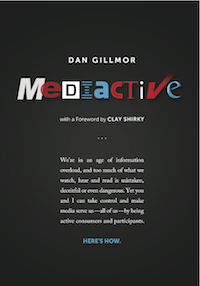 With the publication of his 2004 book “We the Media,” Dan Gillmor established himself as one of the most important thinkers in digital journalism. Because of that book, Gillmor, a former technology columnist for the San Jose Mercury News, is often described as the leading advocate for citizen journalism, though he would be the first to point out it’s more complicated than that.
With the publication of his 2004 book “We the Media,” Dan Gillmor established himself as one of the most important thinkers in digital journalism. Because of that book, Gillmor, a former technology columnist for the San Jose Mercury News, is often described as the leading advocate for citizen journalism, though he would be the first to point out it’s more complicated than that.
When I asked him if he’d like to take part in an e-mail interview about his new book, “Mediactive,” he replied that it might take him a while. Yet, within hours, I received more than 1,500 words of carefully considered prose about the state of journalism and his hope that citizens would use the digital tools at their disposal to become better-educated media consumers — as well as producers.
This is not what you would call an arm’s-length interview. I’ve considered Gillmor a professional friend since profiling him for CommonWealth Magazine in 2006. He offered me some valuable advice on my own book-in-progress on the New Haven Independent and other hyperlocal news projects. I read “Mediactive” in galleys and wrote one of the blurbs. So it would be silly for me to write a review telling you that you should all read “Mediactive.”
Although, in fact, you should all read “Mediactive.” It’s edgier and less optimistic than “We the Media,” but Gillmor has lost none of his passion for urging readers, viewers and listeners — the “former audience,” as Gillmor dubbed them in his first book — to get up off their seats and demand that the media be held accountable.
Gillmor is currently director of the Knight Center for Digital Media Entrepreneurship at Arizona State University’s Walter Cronkite School of Journalism and Mass Communication. He’s also a columnist for Salon and a faculty associate (and former fellow) at Harvard Law School’s Berkman Center for Internet and Society.
Our e-mail conversation follows.
Q: Why did you write “Mediactive”?
A: As you know, I’ve been a cheerleader for democratized media for a long time now. But I’ve also been a cheerleader for quality. And it’s been clearer and clearer that people are not sure how to handle the flood of information that is swamping all of us.
So a couple of years ago, I started realizing that we have a number of issues to work on to make the possibilities for democratized media into realities that would, first of all, encourage creation of media by everyone; and, second, find ways to make what we all create trustworthy and reliable. This isn’t just a supply issue. It’s a demand issue as well.
Clay Shirky, who wrote the foreword for the book, put it particularly well. I’m paraphrasing here, but he said my goal was not solely to upgrade the journalism, but very much to upgrade us, the audience.
There’s a lot involved in doing something like this. It boils down essentially to a modern version of media literacy, one that looks much more at participation than traditional media literacy programs have done while building on the great work in that field when it comes to understanding what we read and see. The bottom line is, above all, persuading passive consumers to be active users of media, both in the reading (used in the broadest sense of the word) and in the creation process.
